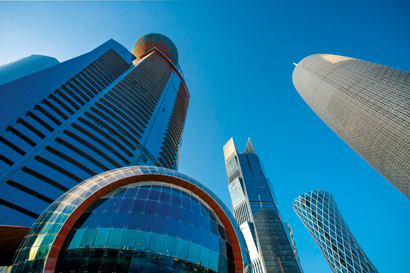Revised government budgets impact Qatar’s realty sector
The third quarter of 2015 has been a period of mixed performance for Qatar’s real estate sector, writes Syed Ameen Kader.
 The recent fall in oil prices has resulted in many Qatari institutions revising their budgets, which has had an impact on demand for office space in Doha. (Image Arabian Eye/Corbis)
The recent fall in oil prices has resulted in many Qatari institutions revising their budgets, which has had an impact on demand for office space in Doha. (Image Arabian Eye/Corbis)
The falling oil prices that prompted the government to revise its spending plans have had some impact on the real estate industry, primarily the commercial sector, but the overall performance has been stable, according to the Q3 report released by property consultant DTZ Qatar.
“While the real estate market performed well in Q2 and Q3 2015, we have seen a change in trends emerge in recent months,” said Johnny Archer, associate director, Research & Consulting, DTZ Qatar. He pointed out that take-up of new accommodation in the office sector has fallen significantly in 2015.
“This is largely due to the fact that the government and the hydrocarbon sector have withdrawn from the market in recent months as their budgets are reviewed,” Archer explained. Further analysis of the sector suggests that most of the commercial activities in recent months have been limited to the private sector, where lettings of smaller office suites of less than 500 square metres (sqm) have been most prevalent. Kenneth Corbin, head of Commercial Agency, DTZ Qatar, said, “This has resulted in a shortage of smaller offices in the market with it being most pronounced in West Bay. This has created upward pressure on rental pricing for those occupiers looking for offices of less than 500 sqm.”
On the parts of residential sector, the increase in vacancies – primarily in the prime residential market – due to recent redundancies in the oil and gas sector, did not result in softening of rental prices because of the overall population growth in the country. According to government data, Qatar’s population reached 2.37 million in May 2015, representing an increase of 9.2 percent year-on-year.
However, other two sectors that continue to perform reasonably well are retail and hospitality. “The prime retail malls are all experiencing high occupancy levels, which is putting upward pressure on rents. There is strong demand for new retail accommodation from retailers who will welcome the arrival of new retail malls in the next 12 months,” said Archer.
On the other hand, the hospitality sector has largely been driven by increasing tourist numbers, which stood at 2.25 million in the first nine months of the year, according to Qatar Tourism Authority’s latest figures. The increase in tourist numbers resulted in an increase in occupancy rates by two percent between January and June compared to the corresponding period in 2014, despite the addition of 15 new hotels to the market. However, Average Daily Rates (ADR’s) for the same period fell by two percent, following the downward trend which has been evident since 2008.
The DTZ report suggests that the occupancy levels would come under pressure in the coming years as up to 4000 new hotel rooms are scheduled to come to the market by the end of 2016.
Like this story? Share it.






